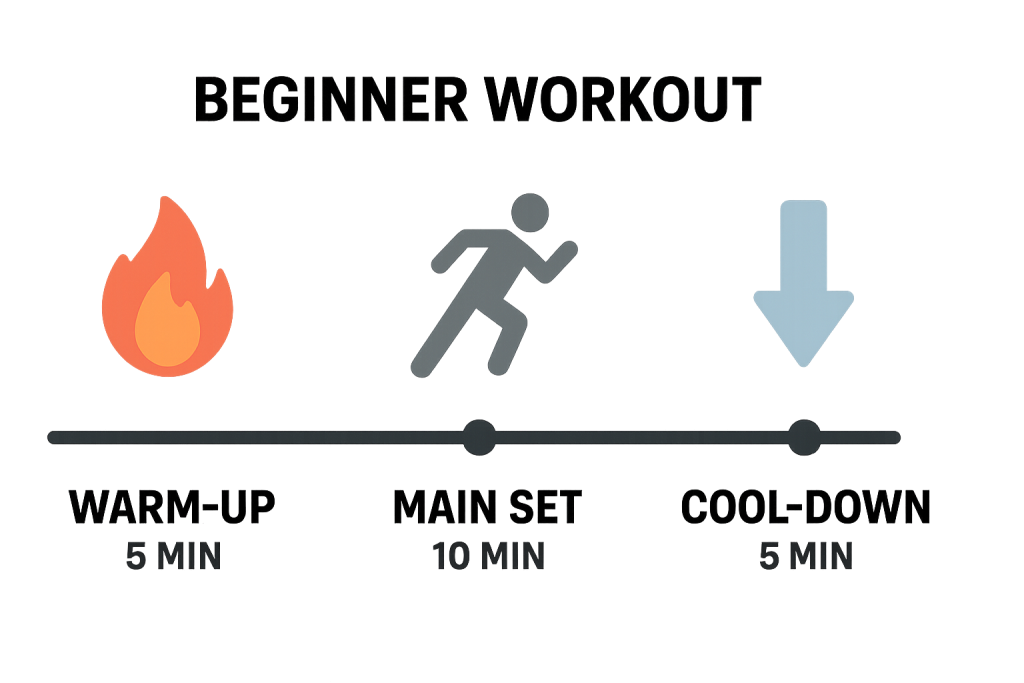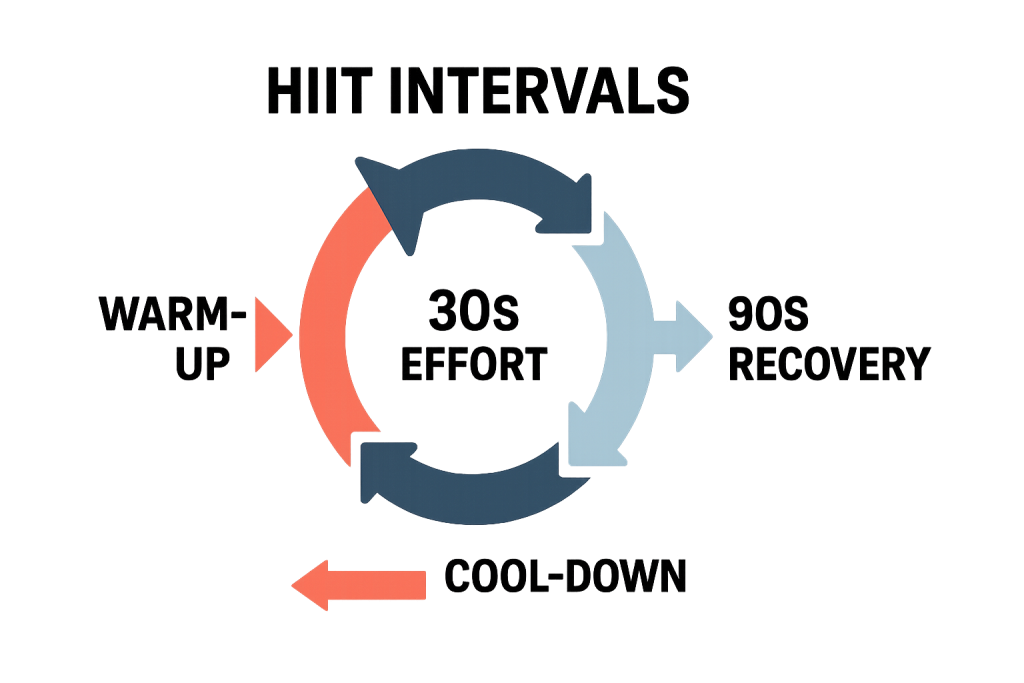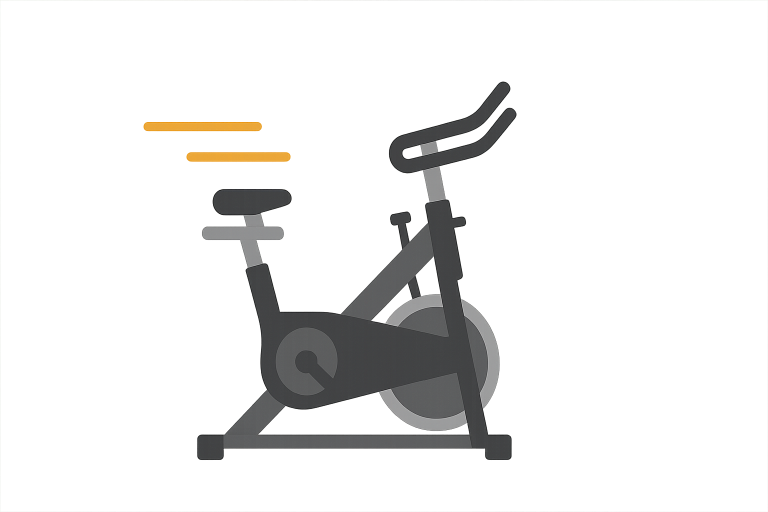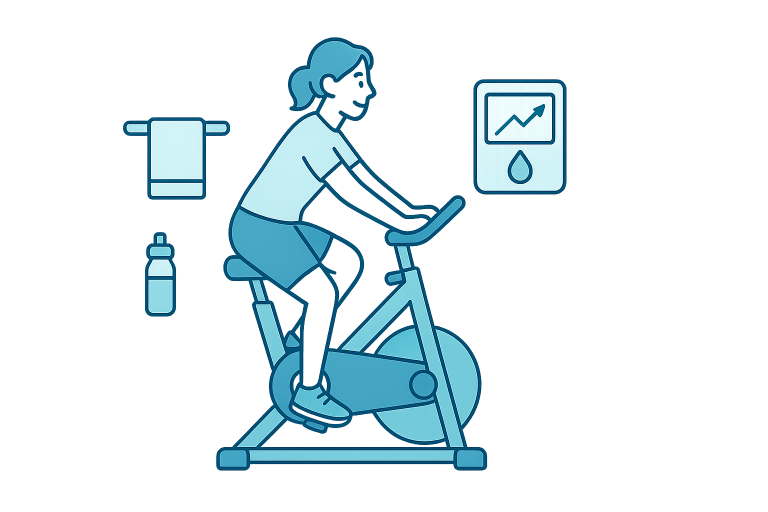Low-Impact Stationary Bike Workouts for Beginners
Low-Impact Stationary Bike Workouts are a top choice for beginners seeking gentle exercise. They offer great heart health benefits while being easy on your joints. Over my seven years as an ISSA-certified fitness trainer, I’ve seen firsthand how a well-planned stationary biking routine can quickly improve your fitness.
I’ve worked with many clients who made indoor cycling a key part of their fitness journey. I watched as they improved their heart health, built muscle strength, and gained confidence. The best part is that starting this low-impact journey doesn’t require an advanced fitness level or expensive equipment.
The Low-Impact Advantage: Why Stationary Biking is the Perfect Start
Stationary biking gives you all the benefits of cardio without putting too much stress on your joints. This makes it a perfect choice if you have a health condition, joint problems, or are new to exercise.
A Workout Without the Strain
The smooth, circular motion of a stationary bike is much easier on your joints compared to high-impact activities. This is especially helpful for people with:
- Knee osteoarthritis or other joint conditions.
- Rheumatoid arthritis flare-ups.
- Previous joint injuries.
- Back problems that prevent other types of exercise.
The secret to success with low-impact exercise is finding the right bike setup and starting at a comfortable effort level. This means focusing on proper form, slowly increasing your effort, and listening to your body.
Joint-Friendly Cycling Tips
- Start with low resistance and an easy pace to see what feels comfortable.
- Focus on a smooth, controlled pedal stroke.
- Increase the length of your workout before you increase the intensity.
- Watch for any increase in joint pain or discomfort.
Addressing Back Problems
Upright, recumbent, and spin bikes all offer different riding positions for those with lower back issues. The goal is to find the right bike and set it up correctly to keep your spine in a neutral, straight position.
- Choose the right bike type for your comfort.
- Adjust your bike to maintain a neutral spine.
- Start with shorter sessions to build core strength.
- Use a moderate intensity that doesn’t hurt your form.
The Many Fitness Benefits of Indoor Cycling
Regular indoor cycling sessions can significantly improve your heart health. The American Heart Association suggests at least 150 minutes of moderate-intensity aerobic exercise each week. A stationary bike makes this goal easy to reach because you have precise control over your intensity.
Building Cardiovascular Health
When you train for a healthy heart, focus on consistency rather than high intensity, especially as a beginner.
- Start with longer, easier sessions to build your aerobic capacity.
- Keep your heart rate in the moderate zone (60-70% of your max heart rate).
- Focus on consistency to improve your blood pressure over time.
Building Strength and Endurance
Indoor cycling builds impressive leg and muscle strength with its adjustable resistance levels. Whether you use light resistance to build a fitness base or higher levels for strength, proper progression supports these changes. Clients who follow a progressive workout plan see faster improvements in their endurance and can sustain a higher effort for longer.
Before You Start: Essential Bike Setup and Preparation
The type of workout you plan determines which bike is right for you. Different bikes use your muscles in different ways, making some better for beginners than others.
Choosing the Right Bike

| Bike Type | Description | Best For |
|---|---|---|
| Upright | Similar to traditional bikes; intense full-body workout requiring core strength. | Those with good balance seeking full-body engagement. |
| Recumbent | Back support; great for longer moderate workouts. | Beginners or those with back problems. |
| Spin | For intense training like HIIT. | Intermediate to advanced cyclists. |
Proper Bike Setup is Crucial
A correct bike setup ensures you transfer energy efficiently, reduces fatigue, and prevents injury. Poor positioning can cause discomfort and make you want to quit.
Adjusting Your Bike Seat
Finding the correct seat height is crucial for comfort and performance.
- Seat height: Your knee should have a slight bend at the bottom of the pedal stroke.
- Correct positioning: This ensures you transfer power efficiently and don’t waste energy.
- Comfort: Proper height prevents discomfort that could ruin your workout.
When you’re on the bike, your hips should stay still. They should not rock from side to side as you pedal. This simple adjustment makes a huge difference in your overall experience.
Finding Your Ideal Form
Using the correct form while cycling maximizes efficiency and prevents strain.
- Pedaling motion: Use a smooth, circular motion to engage your muscles effectively.
- Upper body: Keep your upper body relaxed to allow for better breathing.
- Core: Keep your core engaged to support your lower back and maintain efficiency.
- Hand position: Proper hand placement prevents tension in your upper body.
Your First Workouts: Low-Intensity Routines
Starting with low-intensity sessions helps your body adapt and builds good habits. This approach gradually builds your aerobic capacity without overwhelming your system.
The Beginner’s Foundation Workout (20 Minutes)

- Warm-up (5 minutes): Begin at an easy pace with low resistance. This warms up your muscles and prepares your body.
- Main Set (10 minutes): Work at a moderate intensity. Your heart rate should be 60-70% of your maximum, which should feel like a brisk walk—challenging but manageable.
- Cool-down (5 minutes): Finish by gradually decreasing your intensity. This helps your heart rate return to normal and starts the recovery process.
Building Aerobic Capacity (30-Minute Routine)
This longer workout focuses on maintaining a steady, moderate intensity to improve your endurance. It’s an excellent foundation for more advanced plans.
- Warm-up (5 minutes): Easy pace with light resistance.
- Steady Effort (20 minutes): Maintain a steady effort at moderate intensity.
- Cool-down (5 minutes): Gradually decrease resistance.
This consistent effort allows your cardiovascular system to adapt efficiently and builds the endurance you need for future challenges.
Taking the Next Step: Introducing Moderate and HIIT Workouts
As your fitness improves, you can move to higher intensity and resistance levels. This should be a slow and steady process to ensure you continue to improve without overdoing it.
Safely Exploring HIIT Sessions
High-intensity interval training (HIIT) creates powerful changes, but you need a solid fitness base before you try it.
What is High-Intensity Interval Training (HIIT)?

HIIT involves short bursts of very high-intensity activity followed by recovery periods. It can improve your cardiovascular fitness in less time, burn more calories, and make you more tolerant of high-effort workouts.
The Beginner HIIT Workout (15 Minutes)
- Warm-up (3 minutes): Easy pace.
- Intervals (8 minutes): 30 seconds at a challenging effort, followed by 90 seconds of recovery. Repeat this cycle four times.
- Cool-down (4 minutes): Gradually decrease intensity.
HIIT Safety Rules
- Only try HIIT after you have a solid aerobic base from longer, easier sessions.
- Start with shorter work periods and longer recovery periods.
- Focus on good form even when your intensity increases.
- Allow at least 48 hours of recovery between HIIT sessions.
The Bigger Picture: Stationary Biking for Your Health
Indoor cycling provides excellent heart conditioning, but combining it with strength training creates a more complete workout program. This combination helps you reach multiple fitness goals and build a more balanced body.
Combining Cardio with Strength Training
- Schedule strength training on non-cycling days to allow for recovery.
- Focus on upper body and core exercises to complement your leg-focused cycling.
- Include functional movements that support cycling performance.
Combining cardio and strength training helps improve muscle mass, body composition, and overall fitness beyond what either type of training can do alone.
Stationary Biking and Your Fitness Goals
Stationary biking can be highly effective for weight loss. The key is to create consistent habits that support long-term success.
- Focus on consistency over intensity, especially at the start.
- Gradually increase your calorie burn with longer or more frequent sessions.
- Combine cardio with strength training to maintain muscle mass.
- Track changes in your body, not just your weight on the scale.
- Create a sustainable workout plan that fits your life.
Tracking Your Progress
Tracking your workouts and how your body responds helps you improve and stay motivated.
- Watch for improvements in your endurance.
- Notice when you can comfortably handle higher resistance levels.
- Check for faster recovery heart rates between sessions.
- Keep track of your overall energy levels.
Frequently Asked Questions for New Cyclists
Can stationary biking reduce belly fat?
Indoor cycling can help you lose fat, including belly fat, when you train consistently and make other healthy lifestyle changes. The calories you burn, combined with improved muscle mass and heart health, create ideal conditions for reducing body fat.
How often should I work out on a stationary bike?
For beginners, start with three to four sessions per week. This allows enough time for recovery while you progressively build fitness.
- Beginners (3-4 sessions): Focus on building consistent habits and proper form.
- Intermediate (4-5 sessions): Add variety to your workouts and intensities.
- Advanced (5-6 sessions): Use more challenging training phases.
What is a good target heart rate for beginners?
During steady-state sessions, aim for 50-70% of your maximum heart rate. This intensity is perfect for building a base and is easy to maintain.
| HR Zone | % of Max HR | Purpose |
|---|---|---|
| Easy Recovery | 50-60% | Builds aerobic base. |
| Moderate | 60-70% | Main training zone for beginners. |
| Higher Intensity | 70%+ | Introduce after solid base. |
You can estimate your maximum heart rate by subtracting your age from 220, but keep in mind that this number can vary from person to person.
How can I make my indoor cycling workout more fun?
Variety and engagement are key to long-term success.
- Create themed playlists for different sessions.
- Try virtual apps that simulate scenic outdoor routes.
- Set weekly challenges for distance or consistency.
- Join online communities for motivation and tips.
- Try different types of bikes and workouts to prevent boredom.
The best workout is the one you will do consistently. Find what makes indoor cycling fun for you, and you’re more likely to stick with it.
Start Your Low-Impact Fitness Journey Today
Indoor cycling is an effective, accessible, and joint-friendly way to improve your heart health. Whether you’re dealing with a health condition, recovering from an injury, or working toward big fitness goals, a stationary bike can meet you where you are and grow with you.
The great thing about indoor cycling is how easy it is to adjust. You can start with a gentle 20-minute session and slowly move up to challenging HIIT workouts. All the while, you build the confidence and fitness base that supports long-term success.
From my experience, I’ve seen indoor cycling improve not just physical fitness but also confidence and overall well-being. The mix of heart benefits, muscle strength building, and low-impact nature makes it a truly unique home workout option.
Consistency is always better than perfection. Start where you are, focus on proper form and slow progress, and trust the process. Your future self will thank you for taking that first pedal stroke today.






